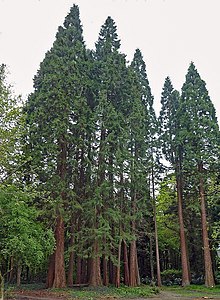Redwood tree
| Sequoioideae Temporal range: Jurassic to present |
|
|---|---|
 |
|
| Sequoiadendron giganteum | |
| Scientific classification | |
| Kingdom: | Plantae |
| Division: | Pinophyta |
| Class: | Pinopsida |
| Order: | Pinales |
| Family: | Cupressaceae |
| Subfamily: | Sequoioideae |
| Genera | |
Sequoioideae (redwoods) is subfamily of coniferous trees within the family Cupressaceae. It is most common in the coastal forests of Northern California.
The three redwood subfamily genera are Sequoia and Sequoiadendron of California and Oregon, United States; and Metasequoia in China. The redwood species contains the largest and tallest trees in the world. These trees can live thousands of years. This is an endangered subfamily due to habitat losses from fire ecology suppression, logging, and air pollution.
Only two of the genera, Sequoia and Sequoiadendron, are known for massive trees. Metasequoia, with the living species Metasequoia glyptostroboides, are much smaller.
Multiple studies of both morphological and molecular characters have strongly supported the assertion that the Sequoioideae are monophyletic.
Most modern phylogenies place Sequoia as sister to Sequoiadendron and Metasequoia as the out-group. However, Yang et al. went on to investigate the origin of a peculiar genetic artifact of the Sequoioideae—the polyploidy of Sequoia—and generated a notable exception that calls into question the specifics of this relative consensus.
Polyploidy has come to be understood as quite common in plants—with estimates ranging from 47% to 100% of flowering plants and extant ferns having derived from ancient polyploidy. Within the gymnosperms however it is quite rare. Sequoia sempervirens is hexaploid (2n= 6x= 66). To investigate the origins of this polyploidy Yang et al. used two single copy nuclear genes, LFY and NLY, to generate phylogenetic trees. Other researchers have had success with these genes in similar studies on different taxa.
...
Wikipedia
